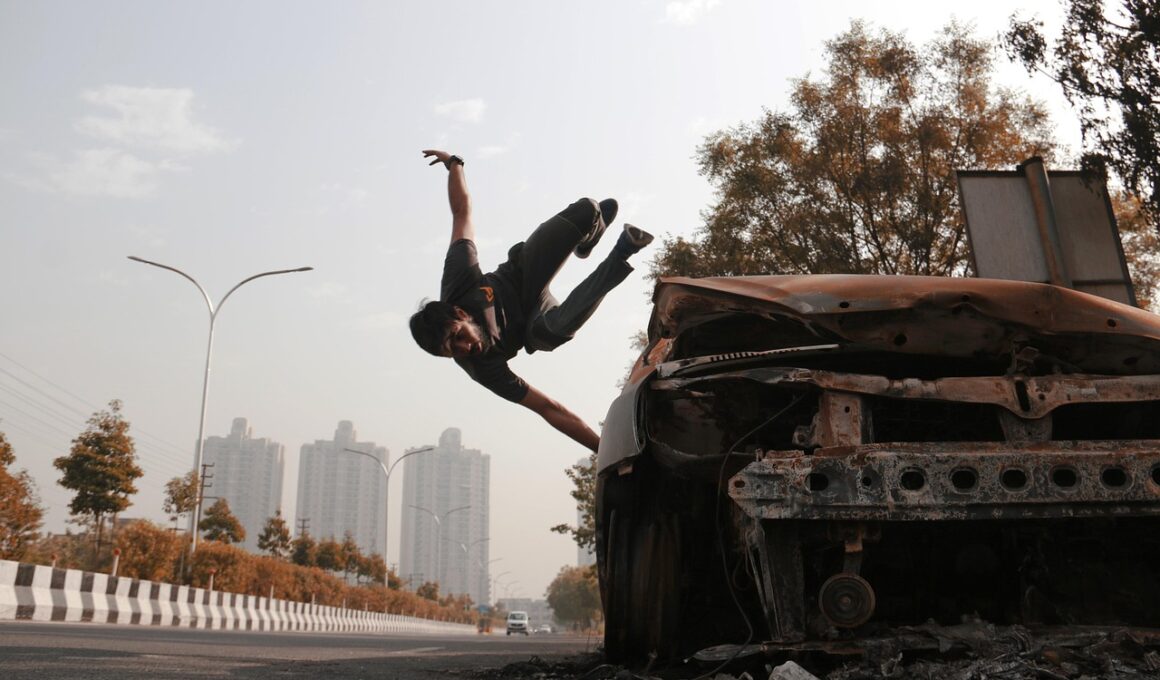The Future of Parkour Coaching: Trends and Innovations
The world of parkour coaching is evolving rapidly as more individuals recognize the benefits of this dynamic discipline. Parkour, rooted in both physical fitness and creative expression, presents unique challenges and opportunities for coaches and practitioners alike. One notable trend is the increasing use of technology to enhance training experiences. Coaches are incorporating apps and digital platforms to provide personalized feedback and track athletes’ progress, making the coaching process more efficient than ever before. This integration of technology not only aids in skill development but also enables coaches to tailor their instruction to meet each athlete’s unique needs. Moreover, the accessibility of online workshops and virtual classes is transforming the landscape of parkour coaching. Athletes from various backgrounds can participate in workshops led by elite coaches regardless of their geographical location. Online platforms foster a global community where knowledge and techniques can be shared widely, enhancing the culture of parkour. This trend is paving the way for greater inclusivity and bridging the gap between beginners and seasoned practitioners, setting the stage for a more connected and innovative future in parkour coaching.
As the parkour coaching landscape evolves, so does the approach taken in workshops and training sessions. Coaches are increasingly focusing on the mental aspect of parkour, recognizing that overcoming psychological barriers is as crucial as physical conditioning. Mental resilience and focus are key components of successful parkour performance, and workshops are now incorporating mindfulness training and visualization techniques. By helping athletes build mental strength, coaches can prepare them for the challenges typically faced during training and competition. Additionally, incorporating injury prevention strategies into coaching programs is becoming a standard practice. Coaches emphasize proper warm-up routines and strength-building exercises to help participants avoid common injuries associated with parkour. Workshops that address these areas not only improve performance but also create a safer training environment. Furthermore, the emphasis on safety is driving the exploration of new materials and equipment in coaching. Innovations such as impact-absorbing surfaces and ergonomic training aids are becoming more prevalent, fostering safer practices while enhancing performance capabilities. Coaches are evolving alongside these advancements, gaining certifications and learning about the latest in sports science to better prepare their students for success.
Community and Collaboration in Parkour Coaching
The future of parkour coaching is increasingly community-oriented, fostering collaboration among athletes, coaches, and organizations. Many parks and urban spaces are being transformed into training grounds through partnerships with local governments and community leaders. These collaborative efforts involve designing spaces that cater specifically to parkour training, ensuring access to proper facilities for burgeoning athletes. Additionally, the rise of community events and open training sessions allows individuals of all skill levels to come together. These events not only serve as excellent networking opportunities but also promote the social aspect of parkour. Participants can share tips, learn from one another, and build friendships while honing their skills. The spirit of collaboration extends online, with forums and social media platforms dedicated to parkour. Coaches leverage these digital spaces to exchange ideas and resources, while athletes gain insights from others’ experiences. Moreover, online competitions and challenges create an inclusive environment, allowing individuals to showcase their skills and creativity. By embracing community engagement, parkour coaching is paving the way for a more supportive and connected future, ultimately enhancing the overall growth of the sport.
As parkour coaching continues to innovate, we are also witnessing an increased emphasis on inclusivity within the discipline. Historically, parkour has been perceived as an elite sport, often attracting only a specific demographic. However, workshops are now intentionally designed to welcome participants of all ages, skill levels, and backgrounds. Coaches are pursuing certifications in adaptive coaching to work with individuals with disabilities, ensuring that parkour is accessible for everyone. This inclusivity not only broadens the appeal of parkour but also enriches the community with diverse perspectives and styles. Workshops now feature specialized sessions for women, children, and seniors, helping to create a more balanced representation within the sport. Additionally, many coaching programs are collaborating with schools and youth organizations to introduce parkour into physical education curricula. This initiative fosters an early appreciation for the discipline, encouraging a new generation of athletes to explore their creativity and build confidence. By prioritizing inclusivity, parkour coaching is establishing a welcoming space for all, reinforcing the core values of respect, resilience, and creativity inherent to the practice.
Integration of Movement Arts
The blending of various movement arts into parkour coaching has become a defining trend, enriching the discipline and leveling up training techniques. Concepts from disciplines like gymnastics, dance, and martial arts are increasingly being integrated into parkour workshops. This diversification not only enhances skill sets but also encourages creativity among participants. For example, incorporating elements of dance can heighten fluidity and expression in movements, while martial arts techniques can improve strength and agility. Coaches are now encouraged to explore unique combinations of these art forms, developing innovative and captivating training sessions. As coaches become more knowledgeable about other movement disciplines, they are better equipped to create unique training regimens that cater to diverse athletic backgrounds. This interdisciplinary approach also sparks interest among newcomers drawn to parkour from other areas. Furthermore, the incorporation of holistic training, which combines physical, mental, and emotional aspects, is gaining traction. Coaches who prioritize this well-rounded approach can foster a deeper connection between athletes and their craft, ultimately leading to improved performance and personal growth.
Technology continues to play a pivotal role in shaping the future of parkour coaching, as innovations in equipment enhance training practices profoundly. Virtual reality (VR) training programs are gaining traction within the parkour community. These immersive experiences allow athletes to practice risky maneuvers in a safe environment without real-world consequences. By simulating various obstacles, athletes can refine their techniques and rehearse scenarios, boosting their confidence and competence. Additionally, wearable technology, such as fitness trackers and smartwatches, is becoming increasingly popular among parkour practitioners. These devices can monitor heart rates, track movements, and provide feedback, offering valuable data for athletes and coaches alike. By integrating this data into coaching sessions, coaches can make informed decisions about training regimens and identify areas for improvement. Social media platforms and content-sharing channels also play a vital role in spreading knowledge and inspiring creativity. Coaches are utilizing video analysis tools to break down movements and provide visual feedback. This allows athletes to view their performances, identify mistakes, and apply corrections more effectively. As technology continues evolving, its influence on parkour coaching will undoubtedly expand, opening new avenues for skill development.
Conclusion
The future of parkour coaching is bright, marked by trends that promote innovation, community engagement, inclusivity, and interdisciplinary collaboration. As technology becomes more integrated into training, coaches and athletes can harness its power to enhance their experiences, leading to tremendous growth within the parkour community. Workshops and training sessions are being reimagined to accommodate various skill levels while emphasizing mental and emotional resilience. The movement art blend enriches the discipline and promotes creativity among athletes. Moreover, the fostering of community connections and friendships enhances the social fabric of parkour, encouraging support among participants. By prioritizing safety and inclusivity, coaches are building environments where everyone can thrive and explore their potential. This collective evolution is ensuring that parkour remains relatable and approachable for future generations. As we navigate these changes, one thing remains certain: the ethos of parkour—creativity, resilience, and adaptability—will continue to empower individuals as they forge their paths in life and sport. Embracing these trends will ultimately lead to a vibrant, flourishing parkour community that continues to inspire and elevate the discipline.
Parallax shifting, characterized by layered storytelling and dynamic compositions, enhances the immersive aspect of parkour workshops while engaging a wider audience in the training process. This innovative approach not only captivates athletes but also helps them understand the deeper impact of parkour as an art form, athletes can craft and tell their stories. Workshops that utilize these techniques allow for personal expression while honing essential skills. The incorporation of storytelling into parkour education is essential for cultivating an emotional connection, inspiring participants to embrace challenges and explore their journeys. As the future unfolds, the combination of increased access to knowledge, community-driven initiatives, and a focus on personal growth will undoubtedly shape the evolution of parkour and its coaching practices, driving inspired athletes to succeed. The blend of creativity, community engagement, and holistic development will elevate parkour coaching to new exciting heights. Each athlete’s journey will reflect their unique experiences. By focusing on innovative methodologies and inclusive practices, the future holds unlimited possibilities for parkour and freerunning, and those who dare to dream and explore new terrains will thrive.


